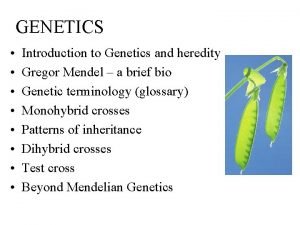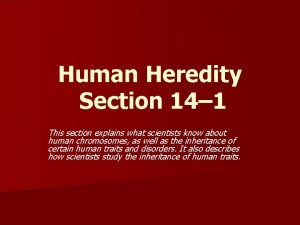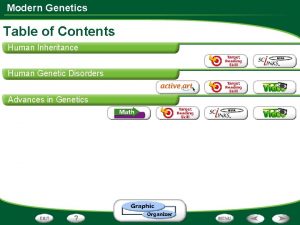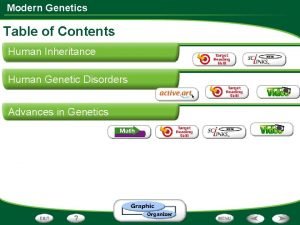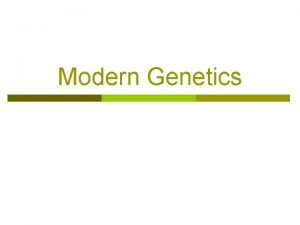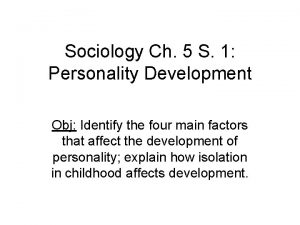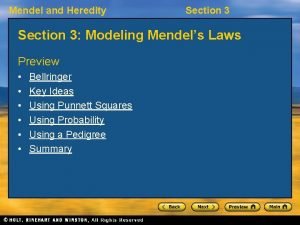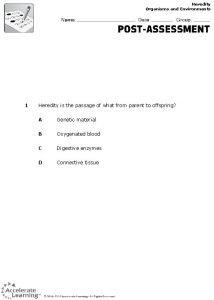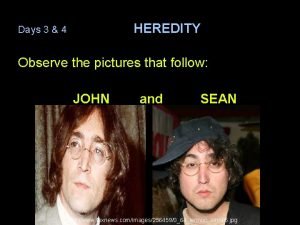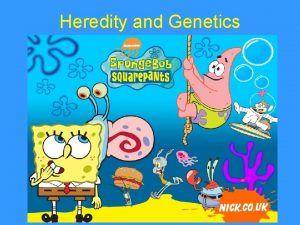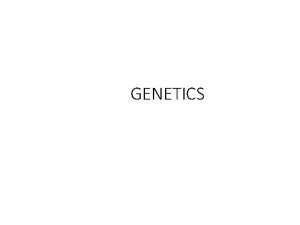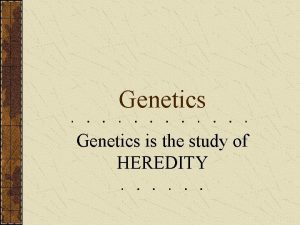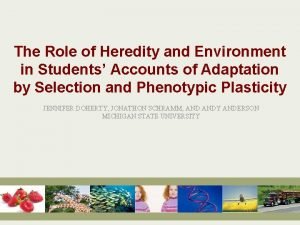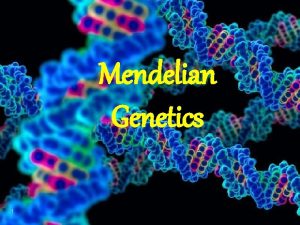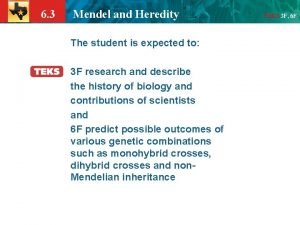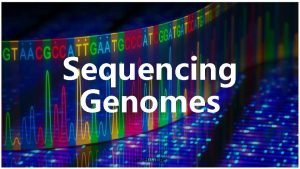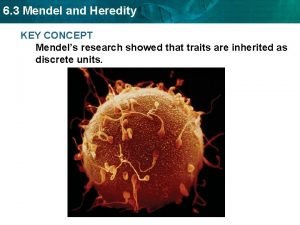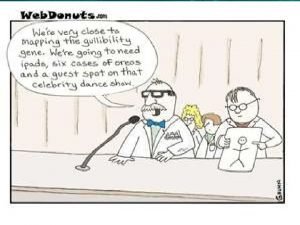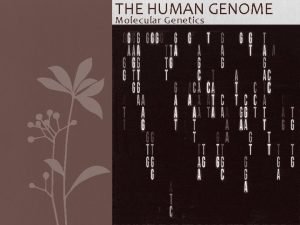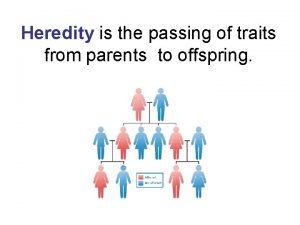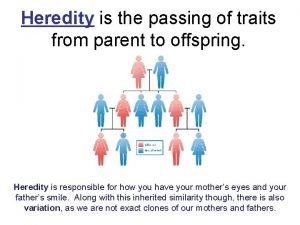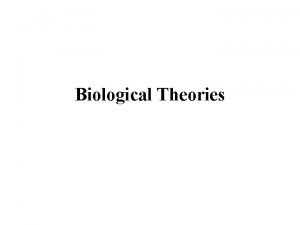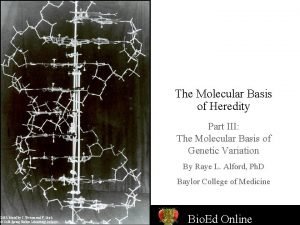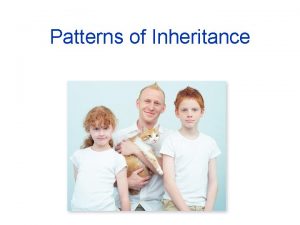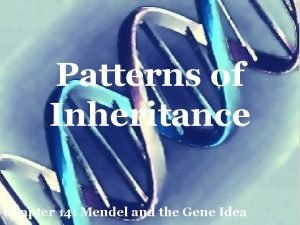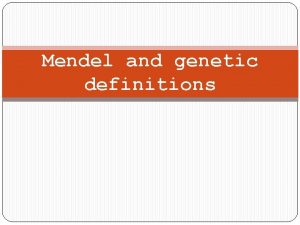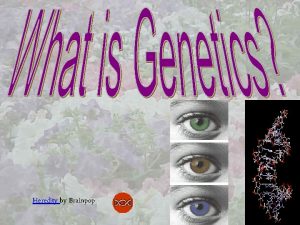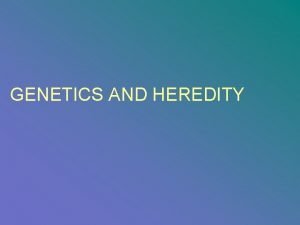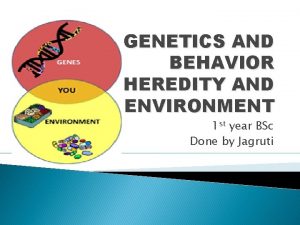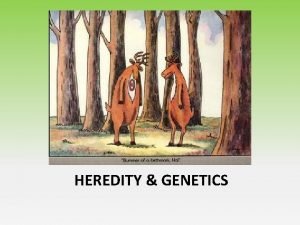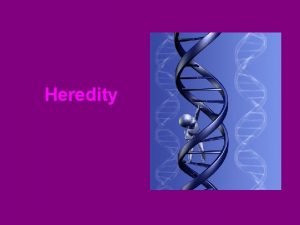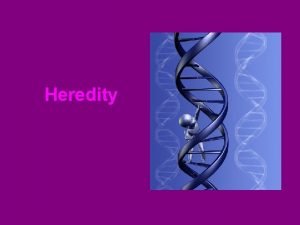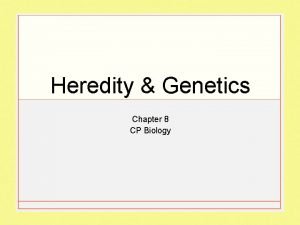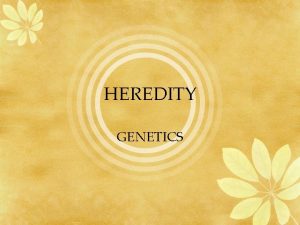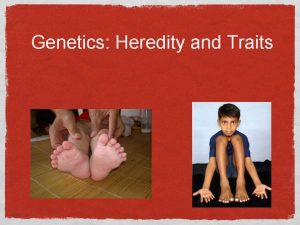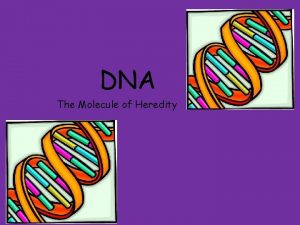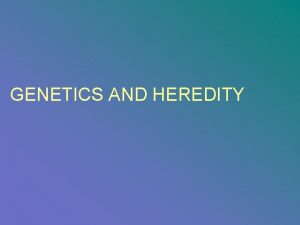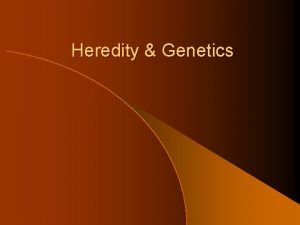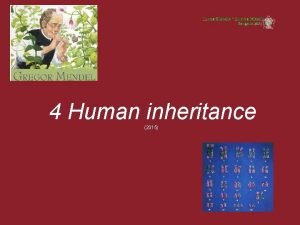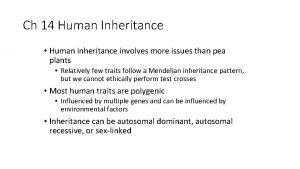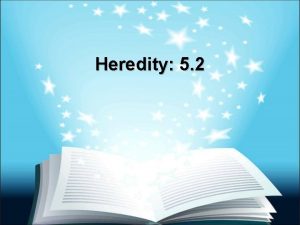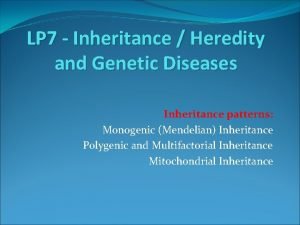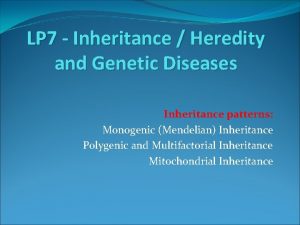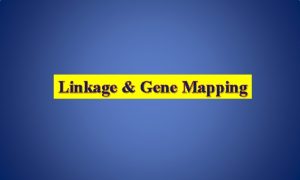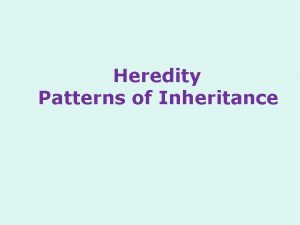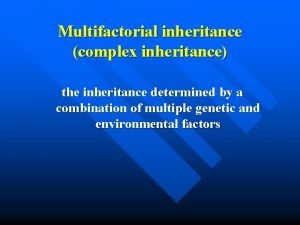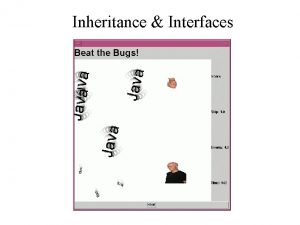Human Inheritance Review What is Heredity Heredity is










































- Slides: 42

Human Inheritance

Review – What is Heredity? • Heredity is the passing of traits from parents to offspring • Genes are passed from parents to offspring (**Remember a gene is the unit that controls traits) • Genes are located on our chromosomes

Autosomes vs Sex Chromosomes • All human cells contain 46 chromosomes or 23 pairs of chromosomes • The first 44 chromosomes (or 22 pairs) are called autosomes • The 23 rd pair of chromosomes are the sex chromosomes – In female the sex chromosomes are XX – In males the sex chromosomes are XY

Karyotypes • A karyotype is a photograph of chromosome pairs. • A normal human karyotype is the result of a haploid sperm containing 23 chromosomes fertilizing a haploid egg also carrying 23 chromosomes (23+23=46) • Karyotypes are used to detect chromosomal disorders and to determine the sex of an unborn child

Normal Female Karyotype This karyotype would be labeled as: 46, XX

Normal Male Karyotype This karyotype would be labeled as: 46, XY

Pedigrees • A pedigree is a diagram that follows the inheritance of a single gene through several generations of family

How to Read a Pedigree Circle = female Square = male Horizontal line connect siblings or spouses Vertical lines connect parents and children Shaded figure = Individuals who are affected by the trait Non-shaded = individuals who are unaffected **Children are place in birth order from left to right

Practice The following pedigree shows the inheritance of a recessive trait. 1. How many generations are shown? 2. How many children did Parents 1 -1 and 1 -2 have? 3. 4. How many were boys? How many were girls? 3. How many children did Parents II-1 and II-2 have? 4. 5. Key: R = Non-affected; r = affected How many were boys? How many were girls? 6. 4. Use the key to determine the genotypes of each person in this pedigree. (Hint: label all homozygous recessives

Chromosome Number Disorders • Number disorders occur because of a failure of the chromosomes to separate correctly during meiosis. • Nondisjunction – chromosomes fail to separate – Nondisjunction in anaphase I: homologous pairs fail to separate – Nondisjunction in anaphase II: sister chromatids fail to separate • In either case, gametes have an abnormal number of chromosomes

Nondisjunction in Anaphase I

Chromosome Number Disorders Number disorders are NOT inherited; therefore they CANNOT be predicted using Punnett squares

Autosomal Number Disorders • Most autosomal number disorders are lethal • The only autosomal number disorder that allows survival into adulthood is Down syndrome

Down Syndrome • Also known as Trisomy 21 because there are 3 chromosomes in the 21 st position • Characteristics: – Flattened nose and face; upward slanting eyes – Growth, behavior and mental development are all retarded – Risk of heart defects • Incidence of having a baby with Down syndrome is higher in older mothers

Down Syndrome

Sex Chromosome Number Disorders • Caused by nondisjunction of the chromosomes in the 23 rd position or the sex chromosomes • Turner Syndrome • Klinefelter Syndrome

Turner Syndrome • Also called 45, X 0 because individuals lack a 2 nd sex chromosome. • Characteristics: – Female – Short stature – Underdeveloped sexually – Sterile (unable to bear children) – Normal life expectancy

Turner Syndrome

Klinefelter Syndrome • Also called 47, XXY because individuals inherit an extra sex chromosome. • Characteristics: – Symptoms appear at puberty – Males shows poor sexual development – Infertile – Normal life expectancy

Klinefelter Syndrome

Sex-Linked Inheritance • A gene is referred to as “sex-linked” if it is located on a sex chromosome (either X or Y) • In humans, sex-linked genes are almost always located on the larger X chromosome. • The Y chromosome is much smaller and carries only a few genes related to sexual development. • Females have 2 X chromosomes; males have 1 X.

Sex-Linked Inheritance • Females will only show recessive traits located on the X chromosome if they are homozygous recessive. • Males will always show a recessive trait located on the X chromosome because he only has 1 X. • Females can be carriers for sex-linked recessive disorders. – A carrier someone who has the defective allele, but doesn’t show the trait.

Sex-Linked Disorders **Important – all of these disorders are sex-linked RECESSIVE**

Sex-Linked Disorders 1. Color Blindness: the inability to differentiate and distinguish colors Ex: red-green colorblindness

Sex-Linked Disorders 2. Hemophilia: Patients are missing an enzyme required for normal blood clotting. – Have uncontrolled bleeding episodes – Treated with blood transfusions

Sex-Linked Disorders 3. Duchenne’s Muscular Dystrophy – Symptoms develop at 3 -6 years of age. – Causes muscle weakening and the breakdown of muscle fibers, leading to eventual death. – There is no available treatment or cure.

Sex-Linked Disorders • Genotypes for sex-linked traits are written using the X and Y chromosomes to show path of inheritance. C = normal vision c = colorblindness Colorblind male = Xc. Y Colorblind female = Xc. Xc Carried female = XCXc **Remember males CANNOT be carriers**

Sex-Linked Punnett Squares • In sex-linked traits, probabilities for male and female offspring must be calculated separately because traits are inherited differently.

Sex-Linked Punnett Square Practice 1. A colorblind female marries a man with normal vision. What is the probability of them having colorblind children? Key: ____________________ Cross: ____________________ Probability of having a colorblind daughter = ______ Probability of having a colorblind son = ______

Sex-Linked Punnett Square Practice 2. A genetics counselor interviews a couple with a family history of hemophilia to evaluate the possibility of having offspring with the disorder. The wife does not have hemophilia, but states that her father had the disorder. The husband is normal. Key: ____________________ Cross: ____________________ Probability of having a colorblind daughter = ______ Probability of having a colorblind son = ______

Autosomal Disorders • Most genes are carried on the autosomes, the 44 chromosomes other than the sex chromosomes. • Most genetic disorders are autosomal disorders. • These disorders affect males and females equally.

Autosomal Disorders • Autosomal disorders can be divided into three groups based on the pattern of inheritance. – Autosomal Recessive: Person needs two recessive alleles to have the disorder – Autosomal Co-dominant: People with a heterozygous genotype express similar symptoms to the abnormal phenotype – Autosomal Dominant: the dominant allele will cause the disorder; only need one dominant allele

Autosomal Recessive Disorders 1. Albinism: characterized by failure to produce the pigment, melanin. – Lack coloration in skin, hair and eyes – At risk for skin cancer – Symptoms appear at birth

Autosomal Recessive Disorders 2. Tay-Sachs Disease: characterized by the inability of nerve cells to break down a specific type of lipid. – Symptoms appear between 3 -6 months of age – Lipid build-up causes seizures, blindness, degeneration of mental & motor skills – Death usually occurs at or before age 5 – Historically associated with the Jewish population

Autosomal Recessive Disorders 3. Cystic Fibrosis: characterized by excess mucus production in the lungs & respiratory system – Symptoms appear just after birth – Suffer from frequent respiratory infections and poor nutrition – Treatment helps patients live to their 20’s & 30’s

Cystic Fibrosis

Autosomal Recessive Disorders 4. Phenylketonuria or PKU: characterized by the inability to breakdown the amino acid, phenylalanine. – Build-up results in severe brain damage & mental retardation – All babies born in US hospitals are tested for PKU because it is easily treated with a diet low in phenylalanine

Phenylketonuria or PKU

Autosomal Co-Dominant Disorders 1. Sickle Cell Anemia affects hemoglobin production. – Hemoglobin is the protein that carries oxygen in our red blood cells (RBCs) – Individuals that are homozygous for the abnormal allele (ss) produce an abnormal hemoglobin which causes RBCs to “sickle” during periods of low oxygen • Ex: stress, high altitudes – Sickled RBCs block vessels causing severe pain and brain damage

Sickle Cell Anemia

Autosomal Dominant Disorders 1. Marfan Syndrome: affects the connective tissue of the skeletal system, eyes and circulatory system Characteristics: – Long limbs, vision problem, susceptible to aortic rupture

Autosomal Dominant Disorders 2. Huntington’s Disease: characterized by deterioration of the nervous system Characteristics: – Fatal disorder – Symptoms arise in the 40’s-50’s – Mental deterioration – Uncontrollable movements
 Chapter 11 complex inheritance and human heredity test
Chapter 11 complex inheritance and human heredity test Genotype
Genotype Section 14-1 human heredity
Section 14-1 human heredity Chapter 11 human heredity section 11-3
Chapter 11 human heredity section 11-3 Extra x
Extra x Human inheritance modern genetics answer key
Human inheritance modern genetics answer key Genetics graphic organizer
Genetics graphic organizer Modern genetics human inheritance answer key
Modern genetics human inheritance answer key Chapter 11 section 1 basic patterns of human inheritance
Chapter 11 section 1 basic patterns of human inheritance Chapter 11 section 1 basic patterns of human inheritance
Chapter 11 section 1 basic patterns of human inheritance Genetic vocabulary worksheet answer key
Genetic vocabulary worksheet answer key Heredity characteristics include body build
Heredity characteristics include body build Mendelian genetics concept map
Mendelian genetics concept map Section 3 mendel and heredity
Section 3 mendel and heredity Heredity defines the passage of genetic material from –
Heredity defines the passage of genetic material from – Pictures of heredity
Pictures of heredity Allele
Allele Heredity
Heredity ____________ is the study of heredity.
____________ is the study of heredity. Genetics is the study of heredity and variation.
Genetics is the study of heredity and variation. Chromosome diagram
Chromosome diagram Role of heredity
Role of heredity Section 3 mendel and heredity
Section 3 mendel and heredity Heredity terminology
Heredity terminology The basic units of heredity
The basic units of heredity Mendel 9 3 3 1
Mendel 9 3 3 1 Sanger sequencing
Sanger sequencing Section 3 mendel and heredity
Section 3 mendel and heredity Section 3 mendel and heredity
Section 3 mendel and heredity Heredity
Heredity Heredity
Heredity What is regeneration
What is regeneration Heredity and crime
Heredity and crime What is 45 chromosomes
What is 45 chromosomes Molecular basis of heredity
Molecular basis of heredity Early ideas about heredity
Early ideas about heredity Dice and coin
Dice and coin Heredity
Heredity Unit 8 lesson 4
Unit 8 lesson 4 Inherited traits are brainpop
Inherited traits are brainpop The scientific study of heredity *
The scientific study of heredity * What is a pheontype
What is a pheontype Difference between heredity and environment slideshare
Difference between heredity and environment slideshare

